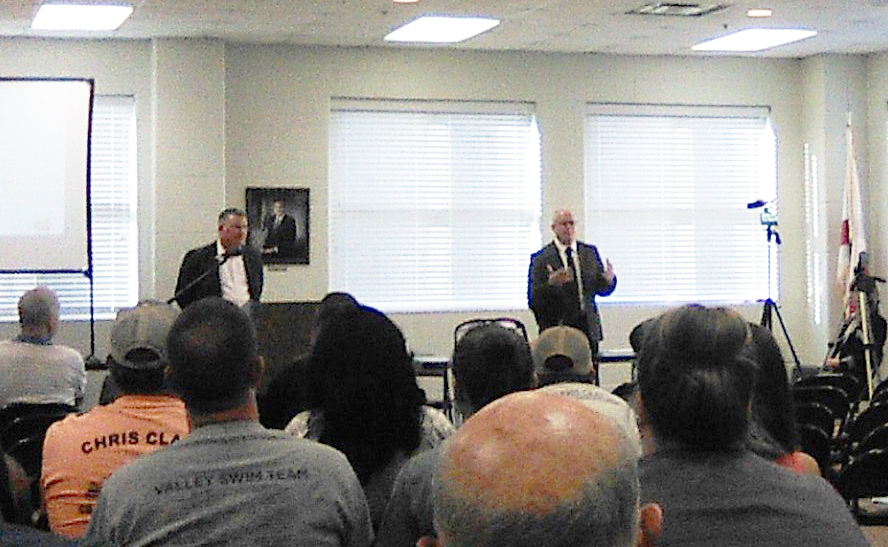

By John Brice
Correspondent
The Chambers County School District held a town hall meeting open to the public at the Valley Sportsplex on Tuesday, September 13th. Making the final decision in the selection process for the location to construct a newly consolidated Chambers County High School that would combine Valley H.S. and LaFayette H.S. was the topic up for discussion. There had been a similar town hall meeting held the night before at Eastside Elementary School in LaFayette to accommodate the residents of that community and their concerns.
Superintendent Casey Chambley started the meeting by outlining the structure to be followed for the proceedings and introduced Tracy Richter, the lead consultant from the leadership firm HPM out of Birmingham, Alabama that is advising the district on the building of the new high school.
Mr. Richter briefly covered the background of how this process of selecting the location for a new high school got to its current point and then began to describe the steps needed to be taken going forward. He spoke about the involvement of the United States District Federal Court for the Middle District of Alabama, the United States Department of Justice and the National Association for the Advancement of Colored People Legal Defense Fund coming to an agreement that satisfied the conditions of decades-old desegregation orders from the federal government which allows the process to move forward.
Richter highlighted the fact that in June there was a meeting of the parties involved which led to the creation of a facilities plan referred to as high school educational specifications which was designed to meet the objectives of the CCSD mission. This plan includes the educational program, space types, size, adjacency and the appearance of the school.
He went on to mention that both the City of LaFayette and the City of Valley have made offers to donate large acreages of land in their possession for use in building the new high school. The cost benefits of the savings from receiving these donated lands instead of needing to purchase them was also emphasized.
Infrastructure is a key consideration when selecting a site, whether it is already in place or would need to be paid for when site readiness is in order vs.earthworks, water, utilities, sewage, road conditions and internet access.
The initial capacity for the new high school is expected to be for 1,000 students and come in at a size of 175-190 thousand square feet with an estimated cost of $70-million to $75-million.
Geographical Information Systems analysis has been performed by HPM to analyze the location of students in the district when placed on a map. This study is useful when calculating travel times for students from their home to the school as well as topography, wetland proximity and how all that factors into which location will ultimately be selected.
The final conclusion from the data examined has determined that the new school will need to be built within the city limits of either LaFayette or Valley since there is no suitable land in the middle of the county which would be a halfway point for the two student populations.
Racial identity of students has also become a critical criteria in the decision due to the demographic differences between the two cities. Sacrifices in terms of increased travel times for students on school buses will need to be made and the decision in regards to what is an acceptable duration of that trip i.e. is one hour acceptable. Students residing in the northern and western portions of the county are expected to spend more time traveling to either site in comparison to the schools they currently attend.
The projected date for construction to begin is July 2023 contingent upon the school board’s ultimate decision and approval from the federal court, DOJ and NAACP which will be dependent on feedback they receive from residents of each community. Once that milestone has been reached there will be eight to twelve months needed for crafting of the architectural design and necessary permits to be received.
Input from citizens will be sought out in further public meetings as the CCSD provides them with relevant information throughout the ongoing process such as the name of the new school, logos, a new mascot and the cosmetic appearance of the building itself.
Next up at the podium was school improvement expert Dr. Stephen Hammock who gave a brief description of the court ordered Desegregation Advisory Committee that he is assisting in the formation of. The DAC as it is known is made up of six volunteers from LaFayette and Valley each, three of them students and three parents from the respective vicinities.
The end result of their efforts will be a school district that is released from federal oversight which has been in place for over fifty years once it has reached unitary and equitable standards for racial composition and quality of education provided.
The question and answer phase of the meeting then commenced with Mayor Leonard Riley addressing the crowd as a member of the audience. He expressed his support for switching the City of Valley from the eastern time zone to the same central time zone that LaFayette is located in to avoid scheduling issues.
The conversation then segued into an extended discussion between Superintendent Chambley and members of the audience regarding the pitfalls and challenges faced by the two communities sharing a single school district when they reside in two different time zones. The town hall concluded with Chambley reassuring the audience that the county was in excellent fiscal shape and should be able to pay for the construction project without any significant increases in taxes for its residents.
